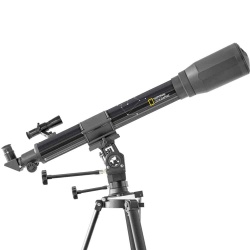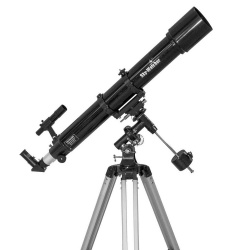Reflector vs refractor: what’s the best telescope?
15 October 2023 | Admin
Telescopes designed for beginners come in two different optical designs. It pays to know the difference before you make a purchase.
What’s the best telescope? It’s a question that’s impossible to answer without knowing a thing or two about the pros and cons of the two main types of telescopes for beginners – refractors and reflectors. After all, would you buy a car without knowing whether it ran on petrol or diesel? Of course not! Knowing what these two types of telescopes are, how they work and what they do best will help you choose a telescope more easily and quickly.
The main differences between refractor and reflector telescopes for beginners are simple to understand:
Now let’s take a look at how they’re designed and what they are best at:
Knowing what reflector and refractor telescopes for beginners have in common is also helpful:
- Both give good views of the moon and planets in the solar system as well as the brighter star clusters and nebulae.
- The most important difference between telescopes for beginners is the aperture – how much light they let in – which is expressed in millimetres and inches. The bigger the number, the better the image.
- Refractors and reflectors for beginners come with a basic altazimuth mount that moves up and down and side to side.
How to tell a reflector and refractor telescope apart
It’s actually very easy to tell apart the two main types of telescope:
- A reflector telescope’s tube tends to be short and fat, with the eyepiece on the side. Reflector telescopes begin at 76mm/3 inches.
- A refractor telescope’s tube is typically long and thin, with the eyepiece at one end. Most telescopes with apertures of 76mm/3 inches or less are refractors.
What you need to know about reflector telescopes for beginners
A reflector telescope has a large curved mirror at the end of its tube to reflect light onto a smaller mirror further up the tube, and then into a focuser. That’s why the eyepiece is on the side. These are known as Newtonian reflectors and are by far the most popular and affordable type of reflector telescope for beginners. If you want as big an aperture telescope as possible for a relatively small budget, the best option is a Newtonian reflector on a Dobsonian mount.
Pros of reflector telescopes
- Reflector telescopes are great value, offering the most aperture for your money.
- A Newtonian reflector with an aperture of 100-150mm (4-6 inches) is typically the best-value all-rounder telescope.
- A Newtonian reflector with an aperture of 150-200mm (6-8 inches) on a Dobsonian mount is the best-value telescope for observing galaxies, star clusters and nebulae.
- The eyepiece and focuser are in a very convenient position.
- Images have accurate colour.
Cons of reflector telescopes
- Most reflector telescopes lack portability.
- Objects appear upside down.
- Images can lack contrast.
- Mirrors occasionally need collimating (re-aligning).
Five examples of reflector telescopes
 | | In stock, immediate despatch |
Dock your smartphone on the award winning app-enabled StarSense Explorer DX 130AZ Newtonian Reflector Telescope and quickly navigate the night sky, ideal for beginners, it includes 25mm & 10mm eyepieces and the Celestron Starry Night software.
Check Smartphone Compatibility - Click Here |
|
 | | In stock, immediate despatch |
The Sky Watcher Explorer-130 Telescope is a great starter telescope that can easily be upgraded. |
|
 | | Awaiting Stock - More Units Expected |
Dock your smartphone on the award-winning app-enabled StarSense Explorer 8" Dobsonian Telescope and quickly navigate the night sky, ideal for beginners, it includes 25mm eyepiece, StarPointer red-dot finderscope and the Celestron Starry Night software. |
|
 | | In stock, immediate despatch |
National Geographic 114/500 compact dobsonian reflector telescope is mounted for immediate use on a flat surface straight from the box. This is a compact dobsonian telescope with 25x-83x magnification, the kit also includes software to locate distant constellations and comes with a 5-year extended warranty |
|
 | | 1 in stock, immediate despatch |
Celestron Astromaster 76EQ astro telescope is quick and easy to setup and requires no tools. |
What you need to know about refractor telescopes
A refractor telescope concentrates light at the end of its tube and into a focuser, so you have to be behind the telescope to look through it. Refractor telescopes designed for beginners typically have apertures of between 60mm-150mm (2-6 inches).
Pros of refractor telescopes for beginners
- Refractors are the most affordable telescopes.
- Refractors give the best views of the moon and planets.
- A refractor with an aperture of 76-100mm (3-4 inches) is easily portable.
- Images are crisp, clear and high-contrast.
Cons of refractor telescopes for beginners
- Large aperture refractors are very expensive.
- Refractors with long telescope tubes are heavy.
- Refractors for beginners usually show a purple fringe around planets and the moon.
- Eyepiece and focuser are in an inconvenient position, requiring a star diagonal (usually provided in the box).
- Objects appear upside down without a star diagonal.
- A star diagonal puts objects the right way up, but creates a mirrored image.
Five examples of refractor telescopes
 | | No stock, discontinued |
The Celestron Inspire 80AZ Refractor Telescope is the ultimate telescope for novice to intermediate astronomers and comes with two eyepieces (20mm and 10mm), erect image star diagonal, a red LED flashlight, StarPointer Pro red dot finderscope, and an integrated smartphone adapter. |
|
 | | In stock, immediate despatch |
National Geographic Refractor Telescope 70/900 The easy-to-use entry-level telescope with flexible Multipurpose mount lets you marvel at the starry sky at night and nature during the day and has a 5-year extended warranty |
|
 | | In stock, immediate despatch |
The Celestron Travel Scope 70 Telescope offers a compact and portable design with coated glass optical elements for clear, crisp images. Comes with a mount and tripod, 2 eyepieces, erect image diagonal and a back to store your scope and accessories. |
|
 | | Awaiting Stock - More Units Expected |
Sky Watcher Evostar-90 (EQ2) Telescopes will stand you in good stead for a lifetime of serious astronomical viewing. |
|
 | | In stock, immediate despatch |
Celestron Astromaster 70AZ astro telescope is quick and easy to setup and requires no tools, comes with two eyepieces 20mm and 10mm for low and high-powered views, upright image diagonal and a
Starpointer finderscope. |
Other types of telescopes for beginners
Occasionally you’ll see other designs of so-called catadioptric telescopes aimed at beginners, typically the Schmidt-Cassegrain and the Maksutov-Cassegrain. These telescopes use a combination of lenses and mirrors to form images.
Schmidt-Cassegrains typically have apertures of 150-355mm (6-14 inches) and specialise in astrophotography. Maksutov Cassegrains usually have smaller apertures of 60-177mm (2.4-7 inches), specialise in observing and are known for their portability. Both of these types of telescopes tend to be more expensive, largely because they typically come on computerised GoTo mounts.























